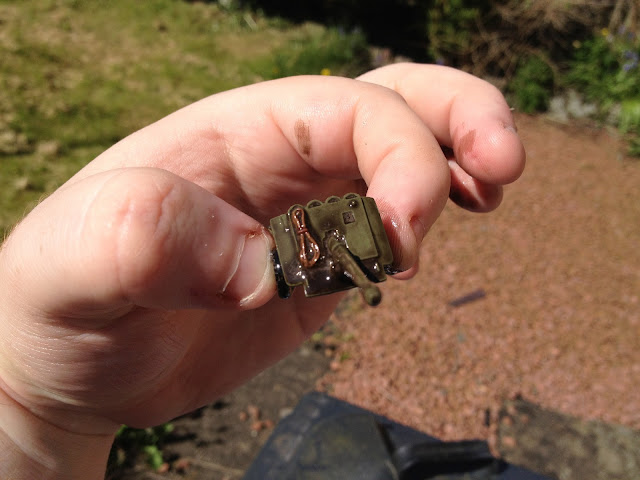Unusually for me this weekend I had my son on the Friday night, meaning tonight I found myself at a bit of a loose end. Yesterday I managed to get all my currently painted model to a point I was happy to move on to applying the Quickshade, so I bit the bullet with the weather being nice today and cracked on with that.
So here's my little tray, ready to go!
Quickshade (after initially using the Mid tone on my models, I was convinced to try the Dark tone) and stirring stick. Turps and a jar for pouring the turps into. Also included (but not in the photo) is my Quickshade brush, which is a beefy .25 inch. I use this for both applying and removing the Quickshade. And also my trusty rag, which I use for cleaning my brush and hands. In the event of a match ever landing near the rag, I may be in trouble.
So, some before shots.
As you can see, I've used this tray before! Also of note at this stage is I'm still working from the lollypop sticks for my infantry and I've not done anything with the bases on the Defrocked Priests.
Incidentally the pack of Defrocked Priests from Waugh Games has never turned up. The company have been very good via email, and it does seem to have just vanished into the postal system. I was down in Middlesborough at the start of the week and they were happy for me to drop in, however did not have the model in stock (the reason they knew it was posted was it had been the last one and needed re-ordered). So far they have been very friendly and helpful and are happy to send me a replacement when the item is back in stock. I'll give them another week or two before asking for a refund.
So, steps for using Quickshade. First of all, make sure it is shaken very well. Then shake it some more. Then open it and stir it thoroughly. For those interested, it looks like this...
So far I've painted a whole Infantry company, about 40 vehicles and 10 or so guns - and I've hardly made a dent, so well worth the money.
I've heard of a few people having issues with this stuff, but most of the time it seems to be that it's not mixed properly. The pigment and the varnish can separate when it's been sitting for a while, so mixing well is critical.
I use the brush on method rather than the 'dip' method, so I load up the brush and really lather it on.
Making sure the model gets a good coverage of the stuff. It's messy and your going to get sticky fingers. This is where you find out if the models put together stoutly. In this process I had one gun lose a trail leg, and one Defrocked Priest lose a .50 machine gun. These will be glued back on later.
The instructions are that you should leave the model well lathered for
about a minute or so, then remove the excess. What i didn't do this time
round was take into account the fact I was doing this outside in strong
(for Scotland) sunshine and with photo's along the way. This meant I may have left the Quickshade on
the vehicles and guns for a little longer than I should have - but this
will be fixed with drybrushing later.I should really have been ready to take the excess of the 1st gun after i had finished the 4th, and same with the tanks.
Not perfect this time round, but every day's a school day!
Next up the infantry. Same idea, really give the Quickshade a stir, then lather it on to really coat the whole model. Don't be shy!
Then after leaving it about a minute (with the infantry the time it took to do all the sticks was perfect timing to take the excess off) just clean the brush, rub it on the rag then use it to dab off the excess, cleaning on the rag as you go.
 |
| Before... |
 |
| After |
Next up for these models will be highlights (and drybrushing for the vehicles). Then a couple of coats of matt varnish to take the shine off.
Addendum: Using the Army Painter Quickshade and the lollypop sticks (as well as models with cast on bases) can see the models being stuck to the tray when the Quickshade dries. It's important that you keep the models apart, so as not to weld them together with the varnish. When it comes to taking the models from the tray, I use a fork to just gently pry the models from the tray. I'm sure modelling knives and the likes would work as well.



























































